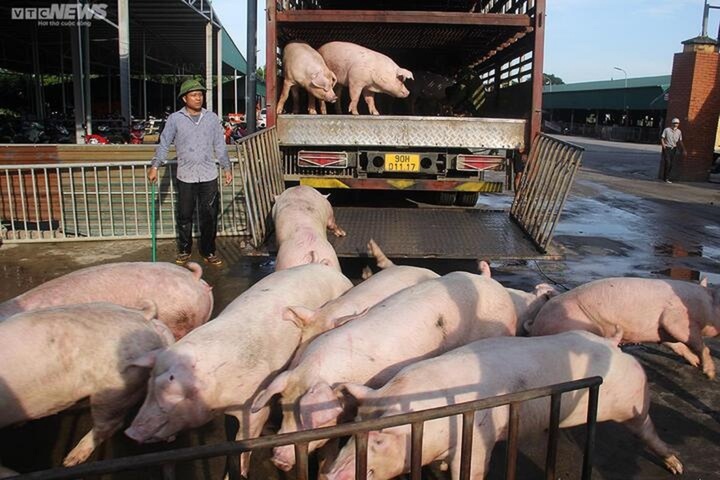African swine fever is re-emerging across the country, severely impacting the livestock sector and raising concerns about a potential pork shortage at the end of the year.
According to the Ministry of Agriculture and Environment, in July alone, 29 provinces and cities reported 571 outbreaks of African swine fever, with a total of 73,488 pigs dead or culled. This is the highest number of outbreaks recorded in a single month so far this year.
From the beginning of the year to the end of July, a total of 978 outbreaks occurred in 724 communes across 33 out of 34 provinces and cities, with 102,755 pigs dead or culled. Compared to the same period in 2024, this represents an increase of 35,738 pigs, or 53.32%.
The Department of Livestock Production and the Department of Animal Health noted that African swine fever is showing signs of resurgence, mainly due to recurrence in previous outbreak areas and new infections in small-scale farms (averaging 50–60 pigs per outbreak), particularly in households that do not meet biosecurity standards.
Faced with this situation, many farmers are reluctant to restock their herds to avoid the spread of the disease, and pork consumption among the public is also declining.

Mr. Trinh Minh Manh, Head of the Economic Department of Binh An Commune (Ninh Binh)—a newly merged area formed from three former communes of Ha Nam Province: Ngoc Lu (known as the northern pork farming hub), Trung Luong, and Binh An—shared that in 2024, Ngoc Lu had around 1,000 pig-raising households with a total herd of over 100,000 pigs.
In recent days, due to complex developments of disease outbreaks, local farmers have sold off all their pigs. Live pig prices have dropped to 62,000 VND/kg, and as a result, most are reluctant to restock until the situation stabilizes.
According to Mr. Manh, at the current price of 62,000 VND/kg, if farmers buy larger pigs and “flip” them within 20–25 days, they can earn a profit of 1–1.5 million VND per pig. However, with prices showing signs of further decline, many are still hesitant to invest in new herds.
“Besides the unstable market price, the ongoing disease situation also makes farmers anxious. Currently, the commune has only about 400 households raising pigs (mostly on a small scale), and only 10 households with more than 100 pigs. That’s a drop of more than 50% compared to 2024,” Mr. Manh added.
Live pig prices currently range from 62,000 to 65,000 VND/kg in northern Vietnam, 57,000–63,000 VND/kg in the central and Central Highlands regions, and 62,000–64,000 VND/kg in southern provinces.
No Pork Shortage Expected by Year – End
Speaking to VTC News, Mr. Duong Tat Thang, Director General of the Department of Livestock Production and Animal Health (Ministry of Agriculture and Environment), said that normally, to meet the year-end and Lunar New Year pork demand, restocking typically begins in September or October to allow enough time for pigs to reach market weight. Therefore, concerns about a pork shortage by the end of the year are premature.
According to Mr. Thang, as of the end of July, livestock operations among enterprises and farms remain fairly stable.
“Currently, Vietnam has over 30 million pigs. With this herd size, we can meet domestic consumption demand through the end of the year, including Tet. Additionally, we expect restocking to resume from early September,” Mr. Thang stated.
Similarly, Mr. Manh affirmed that a pork shortage is unlikely, as farmers can purchase larger pigs and raise them for just 20–25 days, gaining 20–30 kg in weight before selling. “Because this wave-based farming is quick, the herd size will rebound fast once the disease is under control,” he predicted.
Regarding the African swine fever outbreaks, Mr. Thang emphasized that the disease is not unique to Vietnam and is currently affecting over 60 countries worldwide.
“Domestically, recent outbreaks have mostly occurred in small-scale farms and household operations. The fundamental solution is to ensure strict biosecurity practices at every farm and household level,” he said.
In addition to directives from the Prime Minister, on August 1, the Ministry of Agriculture and Environment issued an urgent notice instructing provinces and cities to immediately implement disease control measures to prevent widespread transmission.
The Ministry warned that the disease is becoming more complex and widespread, especially due to the illegal sale of sick pigs, unauthorized slaughter, and improper disposal of pig carcasses into the environment.
In response, local authorities are required to take drastic and urgent measures to control and eliminate the disease. This includes early detection, rapid response, and equipping local veterinary units with sufficient manpower and resources.
The Ministry emphasized that the goal is to control and extinguish the outbreak as quickly as possible, while also preparing conditions to recover and stabilize the pig farming sector after the epidemic.
